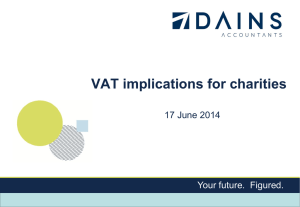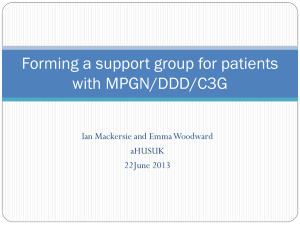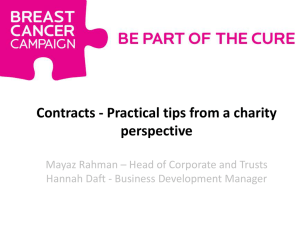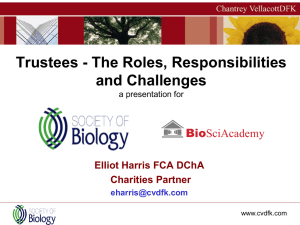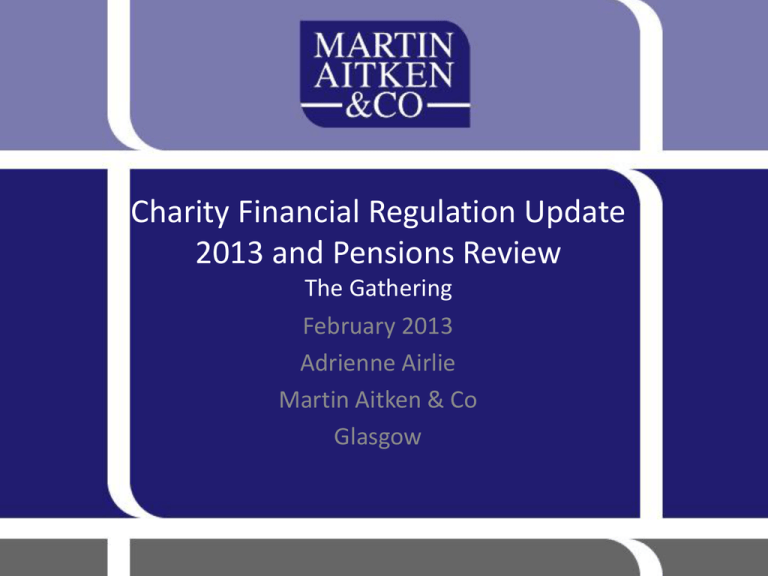
Charity Financial Regulation Update
2013 and Pensions Review
The Gathering
February 2013
Adrienne Airlie
Martin Aitken & Co
Glasgow
Agenda 2013 (1)
•
•
•
•
•
Accounting Standard Changes
– FRS 100/101/102
UK Government - BIS - Audit Exemptions
OSCR
– Annual Review
– Guidance issued
– Current Issues
Scottish Government
– The Charities Reorganisation (Scotland) Amendment Regulations 2012
– SCIOs
HMRC
– Gift Aid
• GASDS
• Charities Online
• Concessions
– Trading
Agenda 2013 (2)
•
•
HMRC - VAT
• Partial exemption
• Cost sharing exemption
• Cultural exemption
• Fundraising exemption
• Listed Buildings
Charities in Challenging Times
– Efficiencies /Governance/Trustees Duties
– External Scrutiny
Added Value
– 1. Internal controls & Governance
– 2. Risk Management
– 3. Succession Planning/ Board skills
– 4. Reserves policy
Future of Financial Reporting in UK
FRSSE
FRS 102
EU-adopted IFRS
Entities eligible for small
companies regime
Entities eligible for small
companies regime
Entities eligible for small
companies regime
Entities not small and not
required to apply EUadopted IFRS
Entities not small and not
required to apply EUadopted IFRS
Entities required to apply
EU-adopted IFRS
Future of Financial Reporting in UK
• FRS 100 – FRS 102
– FRS100 a proposed framework
•
•
•
•
All UK/Irish entities preparing T & F financial statements
Excludes where an entity is required/chooses :
EU-adopted IFRSs or
Financial Reporting Standard for Smaller Entities (‘FRSSE’).
– FRS101 proposed reduced disclosure framework for
• Qualifying entities.
• E.g. your financial reporting is included in T & F consolidated financial publically
available
– FRS102 will replace current FRSs.
• Contains the text of a comprehensive proposed accounting standard
• Based upon the International Financial Reporting Standard for Small and Mediumsized Entities.
Future of Financial Reporting in UK
– 250 pages in total compared to 2,500+ for UK GAAP.
– A more succinct streamlined book with the benefit of simplification
– Sorted by subject area which makes it easier to find the relevant
requirements for a certain topic
•
•
Effective accounting periods beginning 1 Jan 2015
ASB issuing Feb/ March 2013
• FRS 100-102 applies to public benefit entities (PBE) not just to Coys
• PBE Specific requirements within FRS 102
• A PBE is an entity whose primary objective is to provide goods or services
– for the general public, community or social benefit
– where any equity is provided with a view to supporting the entity’s primary objectives
– rather than with a view to providing a financial return to equity providers, shareholders
or members.
Future of the SORP
• The three existing SORPS
– charities, education and housing
– to be updated to reflect the new proposals
• Target date new charity SORP 1 January 2015
• Timescale dependent upon FRS100-102 agreement
• SORP will be progressed once the new accounting
framework is finalised
Audit Exemptions
•
•
•
•
UK Government
BIS Dept. for Business Innovation & Skills - Consultation
Reduce corporate compliance
Audit Exemptions - certain Subsidiaries
–
–
–
–
–
–
•
Audit Criteria
–
–
–
•
Subsidiary nor listed or a bank
Sub must be included in consolidated accounts of the parent and be compliant a/cs
Parent will guarantee all o/s liabilities of the sub at the B/sheet date until paid in full - Unlimited
Shareholders all agree with exemption being taken
Parent discloses that Sub is exempt from annual audit.
Guarantee, Consolidated Accounts and Shareholder agreement all lodged at Coys House
Changes for companies with accounting periods ending on or after 1 st October 2012 to align with small company
thresholds.
Companies now need to meet 2 out of the 3 to require a statutory audit
These do not affect charities which still need to comply with current criteria
Issues
–
–
–
Guarantee, common in charity subs, particularly trading subs
Level of audit work in the Group? Cost savings?
Subsidiary guarantees
OSCR
OSCR – Annual Review 2011
– Accounts compliance
• 76% satisfactory
• 17% qualified pass
• 7% inadequate, re-submit accounts
• Suitable IE/Audit report
• 3 yrs failures still not rectified in yr 4
– Triggers > £25,000 Gross Income
• 38% Possible failure to apply funds for charitable purpose
• 28% Poor liquidity / low reserves/ viability issues
• 17% Transactions with Trustees
– Most prevalent issues re complaints ( 381 - 2011)
• General Governance
• External Disputes
• Misrepresentation
• S23 Failure re info
• Int Embezzlement *
• Trustee duties
• Lack of public benefit
• Personal benefit
*Charity aware
21%
10%
10%
5%
5%
4%
5%
4%
OSCR – Other Assistance
• Case studies
– Charity trustees & personal liability
– Private benefit
– S23 Information request
– Meeting the charity test
• “ Protecting charitable status” issued Feb 2012
– Key learning's for Trustees Section 7 + Checklist
– Good case studies
• Main area for complaint is Governance
– Effective Internal controls & accounting
– 2011 “ Whose in Charge – Control & Independence in Scottish
Charities”
OSCR
“Audit” & Governing Documents
• Constitution, Trust Deed, Memo & Articles
• Reference to “audit”
• Consider change to “the accounts should be subject to external scrutiny in
line with the relevant requirements of legislation” *
• Check permitted, funders, notify OSCR within 3 months.
*OSCR reporter June 2012
OSCR – Equality Act 2010
• Impacts on all charities
• Included on Risk Register
• OSCR Guidance – “Quick Guide to Equality”
–
–
–
–
–
Employer > 25, Association > 25 members
Provision of services
Restriction of benefits – protected characteristic
EHRC guidance
Restriction of users – religions, schools etc.
• Issues for Charities
–
–
–
–
Justification
Beneficial aims
Prevent / Compensate for a disadvantage
Proportionate
Scottish Government
Scottish Government – New legislation
• The Charities Reorganisation( Scotland) Amendment Regulations 2012
– Amended the 2007 Regulations in respect of charity re-organisations
for new thresholds, procedures etc as reflected in :
• The Charities Restricted Funds Reorganisation( Scotland) Amendment
Regulations 2012
• Effective 1/11/12 for Restricted Funds
• Subject to Reorganisation Conditions
• A. Some /all purposes of R Fund have
– Been fulfilled/ provided for elsewhere
– Can no longer be given effect to
– Have ceased to be charitable purposes
– No longer an effective method of using funds
• B. The purposes of the R Fund provide a use for only part of its
property
Reorganisation of Restricted Funds Regulations 2012 (cont.)
• Reorganisation Outcomes
– the resources of the restricted fund to be applied to better effect for
charitable purposes consistently with the charity’s constitution’
• If the purpose of a restricted fund is no longer a suitable and effective
method of using its property, then a reorganisation scheme could propose
new purposes, as long as they are consistent with the charity’s
constitution
• Inability to access/ confirm with donor
• 3 types of restricted fund
Publication
– Large, Property > £1 million Gross annual income > £100,000
– Small, Property < £1 million Gross annual income < £100,000
– Very small, no assets , Gross annual income < £1,000
OSCR + ADVERT
OSCR Only
None?
• OSCR Guidance Oct 2012 , Application form & templates
• Right of appeal
Scottish Government - The Charities Accounts (Scotland)
Amendment Regulations 2010
•
•
•
•
FY beginning 1/4/2011
Reg1(2) Gross Income & liability definitions
Reg1(2) Expendable and permanent Endowments
New definition Gross income
“incoming resources in all R & U/R but excluding the receipt of any donated asset in a
permanent or expendable endowment fund “
• Old definition Gross income
“total recorded income of the charity in all U/R & R funds but not including resources
received as capital funds”
• New definition Endowments
funds consisting of property (which may be heritable or moveable) that has been
gifted to the charity with specific conditions attached and which cannot be spent
except in those circumstances specified
• Recent OSCR rejections of accounts
• Mergers/ acquisition/ transfer of assets
HMRC
HMRC – Gift Aid
• Recap
–
–
–
–
Reclaim tax from HMRC on gross equivalent of donation
Only claimable on gifts of money from individuals, sole traders or partnerships
Donor must pay at least as much UK tax as amount being reclaimed from HMRC
Must keep a record evidencing donation is given under gift aid showing name, address
and details of donation
– Need to nominate an authorised official and register with HMRC to reclaim – use form
R68
• Time limit of four years for making claim
• Budget changes
– Small donations scheme – GA on individual donations of up to £10 to a total of £5,000
without having to collect declarations
– Gift Aid benefit limit increased from £500 to £2,500
• Online filing system from 2012/13
– All future repayments made by BACS
– New Gift Aid Declaration form
Charities Online
• Effective from 22/4/13
• Charities & CASC
–
–
–
–
–
Faster & more accurate claims
Online confirmation & unique ref no, tracking to bank
One amount per sponsored event < £500
Gift aid donations aggregated indiv < £20 up to a total of £1000 per entry.
Detailed listings still accepted.
• Options for claims
– 1. Use an online form
•
< 1000 donor claims
– 2. Claim through the database
•
•
> 1000 donor claims
Software compatibility
– 3. Claim via a Paper Form
•
•
ChR1
Scan
• R68i Forms will be accepted until 30/9/13
The Small Charitable Donations Bill 2013
•
•
•
•
•
The Small Charitable Donations Bill was introduced to Parliament on
21 June. Gift Aid Small Donations Scheme (GASDS) and will be
implemented from 6 April 2013.
Gift Aid Style Top Up payments
Charities have to be in GA scheme already
3 yrs. min
Continued use of GA, fraud restriction
Draft Regulations
• Penalties/ anti avoidance
• Complex
• Third Sector article 17/10/12
Further concession – April 13 – Gift Aid in Charity Shops, donors & donated
goods. Single claim proceeds/ donations up to £100 if charity direct and £1000
if via a trading sub. Guidance to be issued.
HMRC - Gift Aid, Concessions
• Benefit limits
– 25% of donation up to £100
– £25 for donations between £100 & £1000
– 5% of donation above £1000 up to a maximum
benefit of £2,500
• Split payments
– Donor aware of value of benefit at time of
donation
– Quantifiable market value
HMRC - Gift Aid, Concessions
• Example calculation
– Dinner ticket costs £100, value of meal provided is £25.
– Donor is advised at time of purchasing that value of meal is £25 and
signs a form agreeing to donate proceeds under gift aid
– Benefit is 25% of donation therefore whole amount is subject to gift
aid (note that if meal cost £26 it would not be)
– the charity claims back the basic rate tax of 20 per cent from HMRC on
the donation.
– So the charity is able to make a repayment claim of £25 (£100 divided
by 4)
HMRC - Gift Aid, Concessions
• Auction items
– Item is commercially available
• e.g. football top signed by player is not commercially available
– Donor is aware of price when making a successful bid
– Example in notes
• VAT
– Donation outside scope of VAT if no significant benefit
– Split payments – may be a business supply for VAT purposes
– Fundraising exemption applies to events/auctions
Gift Aid - Golf Day example
Golf Day
Numbers attending
Cost per ticket
Total Income
Total
Total Expenditure - paying members
Effective cost per ticket
Effective donation per ticket
Total donations which could be recognised
Members package
220.00
195.00
100.00
19,500.00
25.00
75.00
1,875.00
4,875.00
550.00
230.00
990.00
450.00
25.00
2.50
1.05
4.50
2.05
0.00
2.50
1.05
4.50
2.05
35.09
64.91
12,657.27
10.09
64.91
1,622.73
64.91
12,332.73
3,083.18
21,375.00
Expenses per ticket
Green fees (non members only)
Prize bags
Catering - breakfast
Catering - lunches
Bar
Non-members
7,095.00
14,280.00
Must also consider eligibility for gift aid.
Must be non-corporate entity to be eligible.
Est. 190 are non corporate therefore and 30 are company payments:
Amounts 'donated'
190 ticket donations @
Potential gift aid
Trading
HMRC - Charity Trading & Tax
• Incidental trading exemptions
– £5,000
– < £25% of total income ( up to £50k max)
• Set up a company to avoid tainted activities & tax arising
• Transfer of profit by gift aid – accepted by HMRC
• Payment within 9 months of year end
• Segregates income streams although increases admin costs
• Common misperception that Charities are ‘exempt’ from tax
• Wrong!
• Direct Taxes
– Income Tax/Corporation Tax: Exemptions available
• Indirect Taxes
– VAT ‘Business Test’ – no ‘blanket’ exemption
Charities & Direct Tax
• A number of exemptions are available :
• Primary purpose
– Profits from activities are used only for charitable purpose
• Trade carried out by beneficiaries
– i.e. Charity for disabled runs a café staffed by disabled individuals
– This is a specific exemption in HMRC guidance see http://www.hmrc.gov.uk/charities/tax/trading/basics.htm
– Beneficiaries must do most of the work
• Incidental trading profits
– Maximum £50k turnover from trading activities
– Profits used for charitable purpose
VAT
Charities & Indirect Tax -VAT
• A charity can be carrying out a business activity even though it is for a
charitable purpose
• HMRC uses the business test
– Is the activity carried a serious undertaking earnestly pursued? or function which is
actively pursued with reasonable and recognisable continuity?
– Does the activity have a certain measure of substance in terms of the quarterly or annual
value of taxable supplies made? conducted in a regular manner and on sound and
recognised business principles?
– Is the activity predominately concerned with the making of taxable supplies for a
consideration? Are the taxable supplies that are being made of a kind which, subject to
differences of detail, are commonly made by those who seek to profit from them?
• Precedents on “ business activity”. The case of CCE v Morrison's Academy
Boarding House Association [1978] STC
• VAT not linked to charity structure
• VAT advantages very limited & complex
Charity Income - VAT
Possible VAT scenarios for Charities
Example of Income
VAT treatment
Donation
Non-business and outside the scope
Admission to an exhibition
Standard rated
Sale of brochures
Zero-rated
Catering at a qualifying fund raising event
Exempt
VAT liability – Partial Exemption
Income/Activity of an entity
Business
Taxable includes,
zero, standard,
reduced rate
Non – Business i.e. Grant funding
Exempt i.e. Health &
Welfare, Education, one off
fundraising events, Lotteries
VAT recovery model
Income/Activity of an entity
Non – Business i.e. Grant funding
Business
Taxable
Exempt
Restricted
Unrestricted
Full
Full or none
None
Partial
HMRC- Partial Exemption VAT issues
• Taxable supplies, register - £77k
– Non Business – prov of services at no charge
– Outside the scope - grant income
– Exempt – Fundraising
• Direct Input VAT re a non business supply can never be reclaimed – no de
minimus limit
• Partial exemption
– De minimus limit, Irrecoverable VAT – non Bus – Blocked
– Other input VAT split - Exempt & Taxable, Annual Adjustment
• Voluntary VAT registration – do the advantages re input VAT recovery
outweigh the following ?
1. Admin Costs
2. VAT burden to customers / service users
Charity Income - VAT
•
•
•
•
Donations
– Outside the scope if a genuine donation with nothing received (or benefit) in return
Grant funding
– Outside the scope if charity provides nothing in return
Sale of donated goods
– Normally SR ( but may be ZR, Exempt ) depends on goods
Admission fees
– If free, outside the scope of VAT
– Otherwise SR unless Cultural exemption applies
VAT – Cost Sharing Exemption
•
•
•
•
What is it?
Introduced by FA 2012 following extensive consultation process
A valuable means of reducing VAT costs in shared services
Mandatory provision of the VAT Directive since 1977
– Not previously introduced in UK owing to uncertainty as to how to give effect.
• Back to Basics
• Charge to tax occurs where
– ‘any supply of goods or services made in the UK,
– where it is a taxable supply made by a taxable person
– in the course or furtherance of any business carried on by him
– S 4 VAT Act 1994
• A supply is anything done for consideration.
CSG -Addressing the problem
Cost sharing exemption exempts C’s supplies
Likely beneficiaries:
•
•
•
•
•
•
•
Banks
Charities
Social Housing orgs
Health and welfare orgs
Financial Services
LAs
Educational Institutions
A
What if A and B are:
C
• Charities?
• Housing Assocs?
• Educational establishments?
VAT recovery?
Recharges
B
Cost Sharing Exemption
• Must be an independent group of persons (CSG) supplying services to
members
• Members’ activities are exempt or non-business
• Services supplied by the CSG must be ‘directly necessary’ for a member’s
exempt or non-business activity
• CSG only recovers from its members, a member’s individual shares of
expenses incurred by the CSG in making exempt supplies
• Should not give rise to distortion of competition.
The CSG
•
•
•
•
Can take any legal form
VAT registration
Supplies to non-members
VAT compliance responsibility of the CSG – knowledge of members’
activities!
• Only services received from the CSG that can be ‘directly necessary ‘or
‘directly attributable’ to a member’s exempt/non-business supplies can be
exempted
• Where a member has some taxable activity shared overhead costs could
not be exempted , subject to :• CSGs option of the ‘85% test’.
The CSG - 85% test
• The CSG’s supplies to a member can be exempted where that member’s
non-taxable activities are 85% or more of total activities
• 12 month ‘Look back’ and ‘Look forward’ test
• Members should review PE calculations
• Effective control/communications between the CSG and members is a
must
• Members failing test gives CSG a headache!
CSG Members
• Must be at least 2 members
• No upper limit
• Must have made or have intention to make 5% exempt/non-business
supplies
– In this case CSG services are directly attributable to all exempt/ non
bus supplies
• It is the activities in which engaged and not registration status which
determines eligibility
– Member could be non VAT registered in the scheme
– Just gaining the cost saving advantage rather than the VAT advantage.
– Member is exempt or outside the scope.
CSG - How it might look
Member A
Member B
Member C
Supplies between Members and CSG are exempt
CSG
Subject to normal VAT rules
Non CSG
member
Third party
supplier
Subject to normal VAT rules
Cultural & Fundraising Exemptions
Charity Specific VAT Exemptions
• Cultural exemption
– Non-profit making organisation
– Admission profits applied to continuance/improvement of facilities
– Managed by volunteers with no direct/indirect financial interest
• Fund raising exemption
– Exemption covers ticket sales, admission, advertising space,
merchandise, non-donated auction goods, bar/catering, sponsorship
– There may still be zero-rated supplies – sales of programmes,
children's clothes, auctions of donated goods
– Relief available to Charity and trading subsidiary
– Relief restricted to 15 events per year
– A Charity can appoint an agent/promoter to organise the event and
exemption will still apply.
3rd party large fundraising events
Charity Specific VAT Treatment
• Large fund raising events
– London Marathon
– Charity will normally pay for places in the event and offer to
individuals
– Monies raised will be classed as donations so long as individuals do
not receive any benefits.
• Not classed as benefits:
– Free T –shirt
– Running advice
– Pre/Post-event meetings/refreshments
• Classed as benefits
– Free travel/accommodation
– Bikes/watches
Charity Specific VAT Treatment
• Large fund raising events (cont’d)
• Charities may stipulate a minimum sponsorship figure
• This is an entry fee and is SR
• Excess over this is a donation and outside the scope
– Gift Aid applies subject to usual gift aid declaration
• Some input VAT can be recovered where the Charity makes taxable
supplies
–
–
–
–
Charity incurs VAT on a bike awarded to an individual
A taxable supply.
Recover VAT incurred on the bike.
Minimum sponsorship amount , attributable input VAT could be recovered.
Listed Buildings
Listed Buildings & Approved Alterations
• Changes take place from 1 October 2012
• Affects owners and developers of listed buildings
– Building materials and construction services supplied in the course of
“approved alteration” to a listed building will be standard rated
– Where the building is sold or subject to a long lease, only buildings
reconstructed from shell continue to benefit from the zero-rate
• Developers VAT recovery reduces
• Building owners costs go up by 20%.
• Some good news – increased grant funding for listed places of worship
• Another solution:
– Alteration may qualify for reduced rate
• Many contractors are of the opinion that owners will resort of unregistered cowboy builders
– Substandard alterations and a loss to the Revenue
Challenging times
Charities in Challenging Times
• Be strategic
– Improve efficiencies
• Creative, partnerships/ JV’s
• Public benefit responsibility
– displacement
– People - engagement Senior Team & Trustees
• Sector knowledge
• Support yet question
– Plan, medium to Long term
• Man A/cs, Budgets, Cash Flow
– Reserves
• Careful use
• Manage risks responsibly ( not become risk averse)
• All roles for Trustees
Charities in Challenging Times – Trustees duties
•
•
•
•
S66 Duties of a Trustee, CTI2005
A charity trustee must “ act in the interests of the charity”
– (a) act in a manner which is consistent with its purposes,
– (b) act with the care and diligence reasonable of a person who is managing
the affairs of another person,
– (c) in any possible conflict of interest situation
• (i) put the interests of the charity before those of the other person, or
• (ii) disclose the conflicting interest to the charity and refrain from
participating in any deliberation/ decision.
Any breach of the duties is treated as being misconduct in the administration of
the charity as a whole. Trustees must ensure
• any breach of duty is corrected and not repeated,
• any trustee who has been in serious or persistent breach is removed as a
trustee.
“Ultra vires” action – Joint liability
Charities in Challenging Times CTI 2005 - Trustees Remuneration
• Charity may not remunerate Trustees (incl connected persons) for all
services unless
– S67(3) written agreement re max amount
• Does constitution allow this?
• Must only relate to minority of Trustees
• Reasonable in the circumstances
• In the interests of the charity
– S67 (5) 3 general exemptions
• Authority existed at 15/11/04
• An order of the Court of Session
• Other enactment
– Incorrect payment is Misconduct
Charities in Challenging Times CTI 2005 - Trustees Remuneration
• Remuneration Sec 68(1)
• Contract of employment, service and BIK
• Not reimbursed exps, services include goods supplied
• Payment to a person connected which “might benefit” a Trustee
prohibited, any direct or indirect benefit
• Connected – Sec 67
• Married, partner, same sex couples
• Close family relative, child, sibling, step children etc.
• Coy connected to Trustee – control 20% Sec 105
• Partnership – Trustee or connected person
Charities in Challenging Times – Trustees Duties OSCR
Guidance
• Case studies
– Charity trustees & personal liability
– Private benefit
– S23 Information request
– Meeting the charity test
• “ Protecting charitable status” issued Feb 2012
– Key learnings for Trustees Section 7 + Checklist
– Good case studies
• Main area for complaint is Governance
– Effective Internal controls & accounting
– 2011 “ Whose in Charge – Control & Independence in Scottish
Charities”
Charities in Challenging Times – Trustees Duties, Internal
Controls
•
•
NOT total protection
Sufficiently rigorous controls provides :
– protection for the charity's assets
– best defence for the trustees against
• failing to protect the charity's assets and funds.
• 3 Key Areas
•
1.The 'tone at the top'
– A culture of control embedded in the operations of the organisation
– Created by the trustees /senior management
– Lead by example - adhere to the charity's internal financial controls and good practice.
•
2.Review of controls
– Trustees review annually the effectiveness of the charity's internal financial controls.
– Are they still relevant ? Appropriate ?
•
3. Segregation of duties
•
– No single individual has sole responsibility for any single transaction from authorisation to
completion and review.
Internal controls help manage risk, protect all Trustees.
Added Value
Added Value
1. Internal Controls & Governance
•
•
OSCR guidance – Who’s in Charge 2011
CC 8 – Internal Financial Controls, June 2010
– All sizes of charity covered
– Checklist to follow
•
•
•
•
•
•
•
All Income areas
Purchases/expenses
Assets & investments
Electronic banking/ tiered authority
Restricted Funding
Great advice source for all advisers/ trustees & directors
CC 10 – Hallmarks of an Effective Charity
•
•
•
•
•
•
1. Clear about purposes & direction
2. A Strong board
3. Fit for purpose
4. Learning & improving
5. Financially sound & prudent
6. Accountable & transparent
Added Value
2. Risk Management
• No OSCR guidance
• CC26 – Charities & Risk Management
– SORP requirements for Risk Management
– Model of risk management
– Risks – detailed analysis
• Governance. Operational. Financial. External Compliance –
Annex 1 & 2
• Worked examples
• Disaster Recovery Planning
• Heat Map
Added Value
3. Succession Planning – Board Skills
• Skills Audit & matrix for the Board
– Leadership
– Strategic Leadership
– Communication
– Interpersonal skills
– Technical/ Educational skills
– Understanding Finances/ Legal /HR
– Meetings
– Creativity/ Lateral thinking
• NCVO Website – Good Practice in Trustee Recruitment
Added Value
4. Reserves policy
• CC 19 Charities & Reserves
– Why?
• Confidence, Financial Management & Planning
• Sustainability, risk management, strategic planning, budgeting
– How?
• Nature of funds, risk policy, strategic & operational plans
– When?
• At least annually in detail, monitor monthly as part of accounts/ budget
process.
– What?
• Reliability, prospects, commitments
• Annex 1
– Smaller/ uncomplex charities
Added Value
4. Reserves policy (Cont)
• Can Trustees explain / understand the policy
– Excesses/ deficits/ variances
– Zero level reserves
– Endowments/ Investment returns
• CC19
– Annex 2
•
•
•
•
•
•
•
Understand funds
Functional assets
Financial impact of risk
Sources of income
Future plans/ commitments
- Designations
- DB Pension Scheme
Added Value
4. Reserves policy (Cont)
–
–
–
–
CC12 Managing Financial Difficulties & Insolvency in Charities
Role of Trustees in effective Management & Financial control
Value of the Balance Sheet
Insolvency definition
•
•
Cash Flow test
Balance Sheet test
– Operation whilst apparently insolvent
•
•
•
Going concern
Claims on Funds
Professional advice
– Liquidation/ Administration
– Liability of charity trustees
– OSCR involvement
Charity Financial Regulation Update
2013 and Pensions Review
Any questions?
ada@maco.co.uk
Notes – www.maco.co.uk
Pensions




